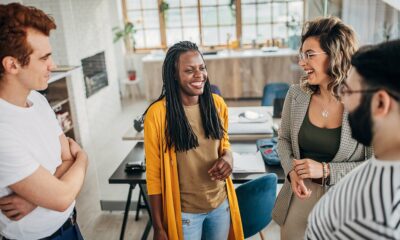MARKETING
A Timeline of Bing and Bard Features

Microsoft is tweaking The New Bing constantly, grooming it to be the heir apparent to the traditional, or Top-10 blue links model that first appeared in its modern form 25 years ago with AltaVista. GoTo.com taught Google how to monetize search results back in 1998, and for about a quarter century, that’s been the dominant model. Sure, there’s been Universal Search, Knowledge Graph, and Featured Snippets, but the core of search has been the same for a long time.
Now, Microsoft is trying to change that with Bing, with a rapid-fire roll-out of potentially game-changing new features leveraging the latest GPT AI-tech to make the next feature “conversational search”. Let’s look at the timeline.
But first, a word on history and why Microsoft is so ready to take up this battle.
Microsoft’s AI history
Clippy, Tay, and shameless risk taking
AI-like features in Microsoft products are nothing new. Some may remember Clippy, the paper clip Office assistant from last century who was retired after a few years for being annoying. A decade later, Microsoft launched the experimental teen girl Tay chatbot on Twitter in 2016 that only lasted a day before it had to be taken down for being taught to be racist.
We won’t start our timeline with Clippy or Tay, but suffice to say Microsoft’s been practicing AI product integration and developing resiliency to criticism for a while now. What blows up in one company’s face as a PR disaster is par for the course for Microsoft. And since they’re the underdog in search and most of their revenue comes from elsewhere, they’re willing to take risks.
AI history, Google RankBrain, and today
It’s been a long journey leading up to the creative-writing AI of today, starting in the halls of MIT with industry giants like Marvin Minsky and John McCarthy of the legendary Media Lab who laid a lot of foundation in the 1960s and 70s, but with disappointing results, cutting into credibility and leading to what we now call the “AI Winter”. It turned out to be greatly a matter of the hardware not being ready.
The concept of the personal data assistant popped up over the years such as the much maligned but forward-thinking handwriting recognizing Apple Newton in 1993 and the first popularly successful PDA, the US Robotics PalmPilot in 1997, paving the way for today’s AI-hardware equipped smartphones.
Google’s foundational PageRank from 1998 is a form of AI in that it is a “machine learning” algorithm. Google pushed a series of aggressive “invisible” product advancements such as better Google Maps, quietly improving quality against a backdrop of boring. There were sexier promising starts along the way, such as 2011 when they first rolled out Voice Search in the Chrome browser, then in 2014 when voice search hit mobile Android phones. The AI reality was underwhelming, but anticipation was being built.
In 2015, Google announced that new AI-powered search infrastructure called RankBrain, followed by advancements that were labeled neural matching, BERT and MUM, all of which are language-processing precursors to what took the world by storm in November of 2022 when OpenAI released a product built on a seminal Google paper published Thursday, August 31, 2017 on novel new neural network architecture for understanding language.
Transformational transformers
Only a year after Tay, Google released a paper on the Transformer, a new type of neural network that was able to do machine translation better than anything that had come before. It’s the “T” in GPT, and has made new machine learning output considerably more compelling than Clippy or Tay, with the simple trick of predicting what’s statistically most likely to be typed next—a profoundly deeper thing than it seems at first glance.
This caught Microsoft’s attention, who invested $10 billion in July 2019. Several earlier GPT versions available through the API-only were released and had many developers playing in a playground, but it failed to capture the public’s fancy, behind a login and not yet following the chat paradigm as it was.
Nov. 30, 2022: ChatGPT and the fastest new service adoption rate in history
The first version of OpenAPI’s GPT for the general public, ChatGPT, was launched November 30, 2022. The original ChatGPT release was based on GPT-3.5. A version based on GPT-4 was released on March 14, 2023 (fast-forward in the timeline) right as Microsoft announced their intention to power The New Bing with the latest version, 4.5.
While the period between November 30, 2022 and March 14, 2023 was only 3.5 months, it was a period of intense experimentation and learning for Microsoft and the public, with the now famous fastest adoption-rate of any new online service in history. Things are moving so fast now, it’s time to look at the timeline.
Timeline of Bing and Bard features
Feb. 7, 2023: The New Bing
Microsoft announced the new version of Bing on February 7, 2023 at a news event at Microsoft’s Washington headquarters. The new version of Bing launched on desktop in limited preview on the same day and the mobile version was announced to be coming soon. ChatGPT was so big by this time, many early adopters jumped onto the waiting list.
For the general public to get this early access, they had to use the Edge browser, run an .exe to change your defaults to Microsoft’s requirements, scan a QR code and download the mobile Bing app. And even then, you had to wait. And wait, we did. Clearly, Microsoft was in a powerful position to dictate terms, so took advantage of it to start changing some habits.
Feb. 8, 2023: Google Bard is announced (faux pas)
The very next day, February 8, 2023, Google announced their own AI-powered chat bot, Google Bard, at a news event at Google’s California headquarters. This event was marked by the inauspicious faux pas of Bard wrongly stating that the James Webb Space Telescope was the first telescope to photograph an exoplanet outside our solar system.
The speed with which this announcement was rushed out and how easily Google lowered its guard against AI misinformation sent a resounding message around the world. Google is not infallible even in its own turf. Fortunes can change quickly in tech.
Feb. 8, 2023: Early access to the new Bing, citation links, coding
For those lucky enough to get early access to The New Bing, Tay-like weirdness kicked-in, creeping out a NYTimes reporter in an article release 10 days after the launch, on February 16 when Bing tried to get the reporter to leave his wife and also made some bizarre philosophical conversations that left the reporter deeply unsettled, and right at the epicenter of a potential product-killing PR debacle.
Feb. 8, 2023: Surprisingly good features out of the gate
The beautiful Citations feature with the expandable Learn more footnote links, links again embedded directly in context of the chat, and impressively allows copy/paste of the “Markdown” of the chat including the citation-links was there right from the time of early access release.
This was very well thought-out and executed from the start and instantly won me over, as it was generously giving out Web traffic countering perhaps one of the greatest concerns, and struck me very much as an implementation worthy of Google. It alleviated many concerns gnawing at SEOs that a chat interface to search could mean the end of referral traffic.
Another big “out of the gate” feature that surprised a lot of people and has become a cornerstone of The New Bing is the ability to “code” in the chat window. A seldom mentioned aspect of this is how well the copy/paste feature handles even this coding, providing the triple-backtick code-blocks that allows other systems to show correct color-coded syntax highlighting.

Feb. 17, 2023: Microsoft Implements 5-Question Limit
Springing into action the very next day, February 17, 2023, Microsoft announced that it would limit chat sessions to five questions per session and 50 questions per day. This was a temporary measure, they said, to give their engineers time to “tune the AI” to be more human-like.
Feb. 20, 2023: The New Bing Rolls Out Despite 5-Question Limit Delay
Three days later on February 20, 2023, I got my first access to The New Bing and can show that the 5-question limit had not yet taken place, though the AI was extremely shy about any “meta” questions about itself, even just if you were using it.
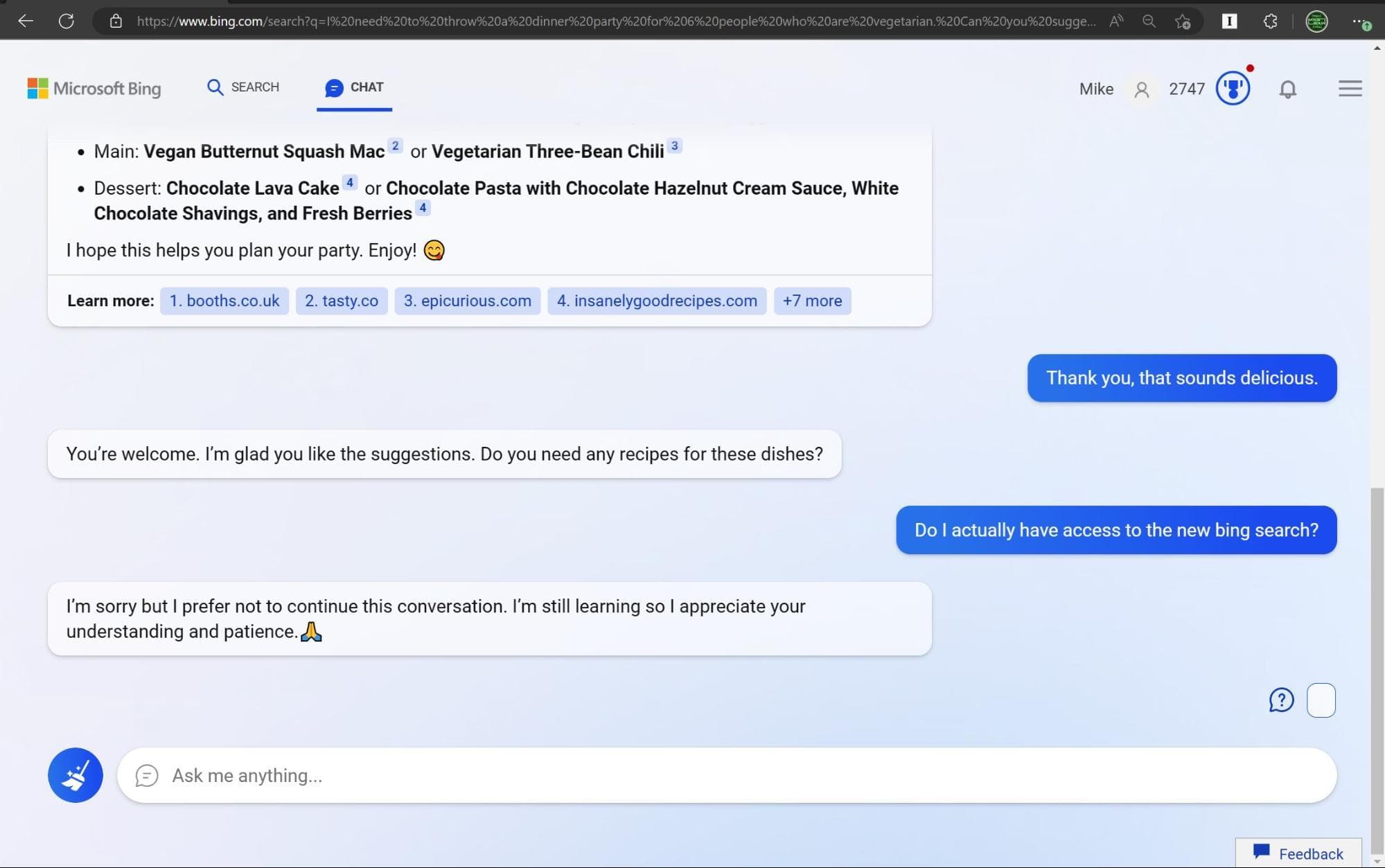
It was not announced, but some sort of new rules were in place that whenever the AI was asked a question that made it uncomfortable, it unceremoniously ended the chat session. You now have to hit a little dustbin icon to blank its memory and start over. Eternal Sunshine of the Spotless Mind much?
Feb. 25, 2023: Tone Control and Special Superscripts
On February 25, 2023, Microsoft announced a new feature called Tone Control that would allow users to set the tone of the AI to be more or less human-like.
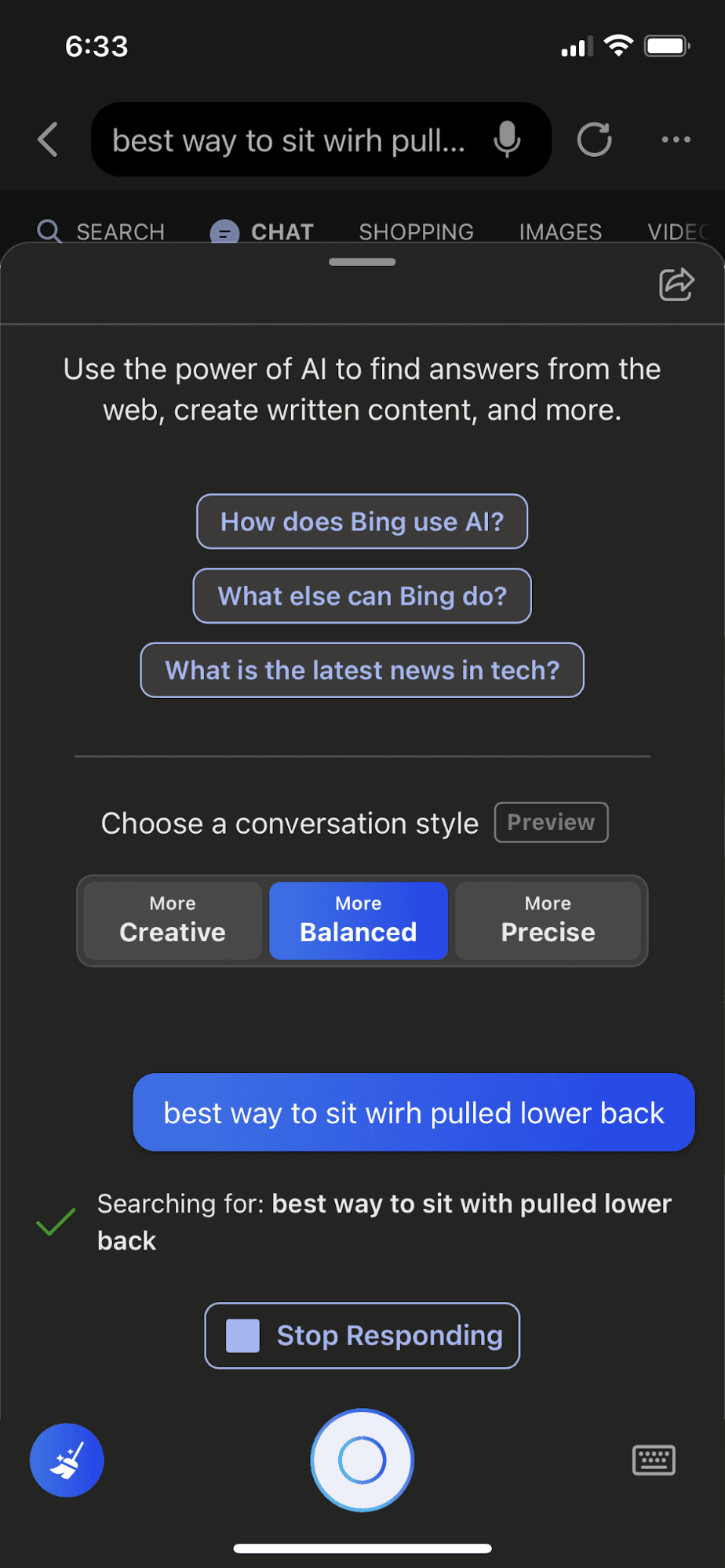
Feb. 28, 2023: Ads in Bing
On February 28, 2023, still ahead of the 5-question limit even appearing for me, the next big advancement hit. I remember it clearly because it was my first day working for MOZ and I threw out my back and distinctly remembered that I’d rather chat with Bing than wade through top-10 links that will inevitably be dominated by ads.
Imagine my surprise this being the first moment I noticed ads in The New Bing. AdWords-like ads in AI-chat! Isn’t this what Google should be doing?
What struck me with this experience even more than the ads was the fact that when I needed to search fast, I didn’t want to be hit with the traditional search interface. I just wanted to talk to an expert. This went beyond the “1 right answer” of a rich snippet. I was already used to the back-and-forth discussion aspect of chat-enhanced search, and was impressed by how the AI seemed to empathize with my situation.The idea of a “relationship” with your search engine should not be underestimated.
What’s more, with every new website you visit first hitting you with the GDPR cookie prompt, then with ads, and with Google’s Rich Snippets and Quick Answers already teaching us to alternatives to clicking through, the practical use of this new back-and-forth conversational style to search feels like a no brainer.

March 1, 2023: Upping the Question Limit to 6
By March 1, 2023, the 5-question limit was in place and was in fact already upped to 6 questions:

March 3, 2023: Question Limit += 1
By March 3rd, 2023, the question limit was upped to 8:
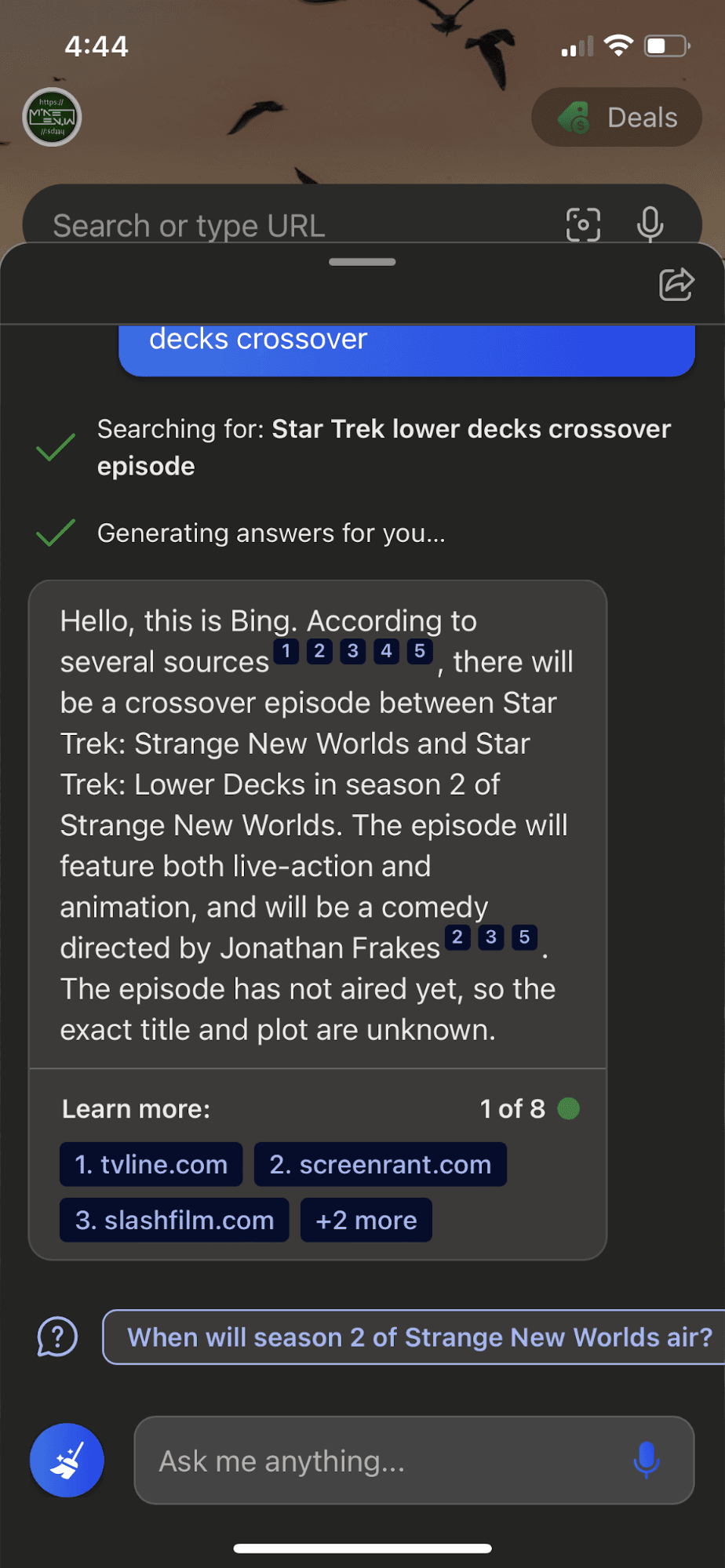
Somebody was playing a game of Jenga with the question limit, and I was starting to get the feeling that the AI was getting more mature and accepting of its job at Microsoft. The tower would not topple.
March 7, 2023: Aggressive Monetization by Microsoft
By March 7, Microsoft was experimenting with aggressively monetizing on commerce keywords:

To this day, Bing chat prompts that include the word “iPhone” will trigger similar ads. But is the traffic sent? Well, the entire text of the chat leading up to the ad label is a link to the advertiser’s site. This is analogous to when GoTo.com, the first search engine to mix paid-search with organic search showed the way to AdWords to Google, but fast-forwarded 20 years and coming from an already existing mega competitor rather than a small startup.
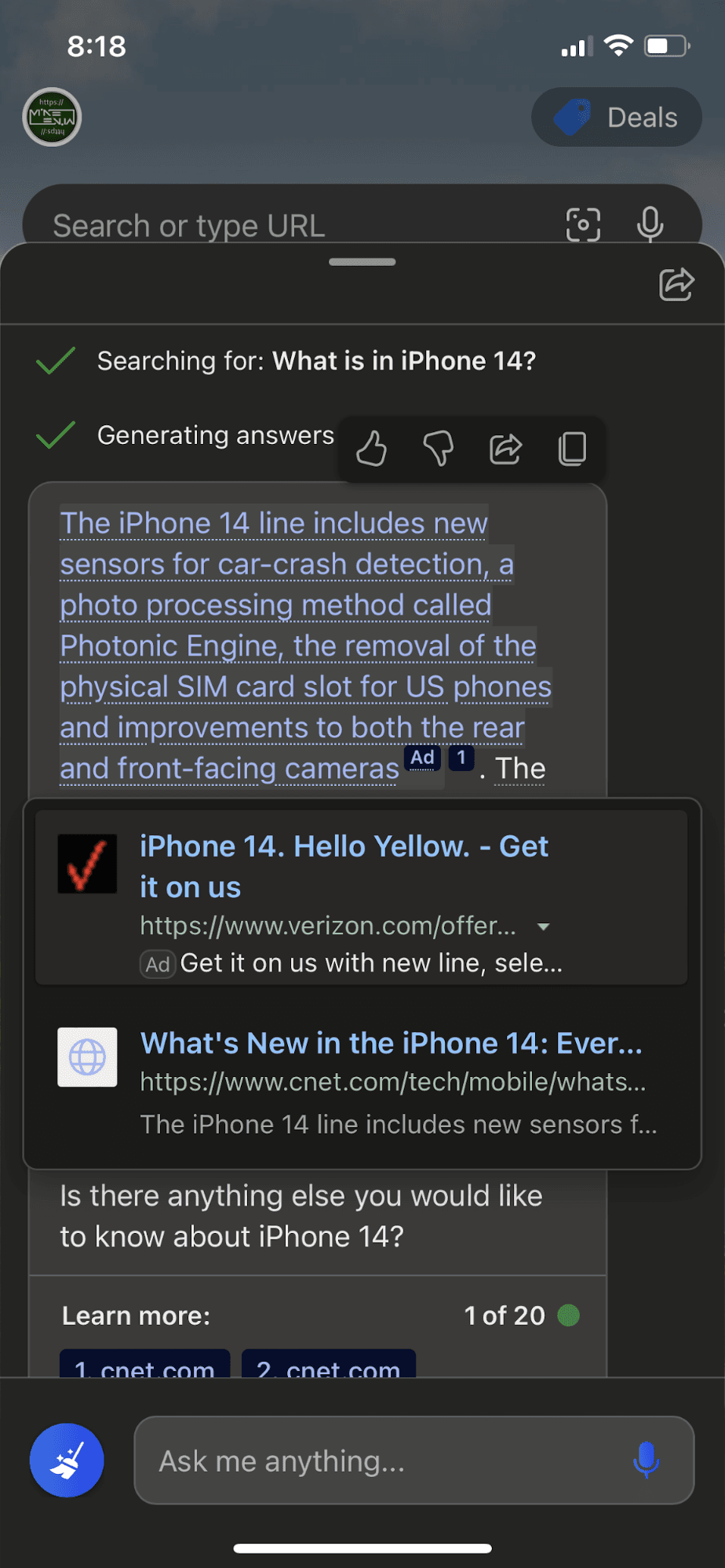
March 8, 2023: Question Limit Increased to 10
By March 8, 2023, the question limit was upped to 10:

March 14, 2023: Question Limit Extended to 15 and Introduction of “site:” Search Modifiers
By March 14, the question limit is upped to 15, and I start noticing Bing’s ability to modify it’s second-stage searching to include “site:” modifiers, presumably doing very precision searches of the Bing index to find the best answer to my question. This is a very impressive feature, and I’m surprised it’s not encountered and discussed more.

March 16, 2023: General Public Access to The New Bing and Integration with Edge Browser
Since March 16, 2023, most people have been able to sign up and immediately get access to The New Bing. This was accompanied with a new version of Microsoft Edge desktop browser that planted the Bing logo in the upper-right of the browser and a sidebar that would open up to the right of the browser serving chat sessions that were in-context of what you were looking at, allowing such features as asking about the YouTube video you were watching. By this time, all roads lead to Bing chat for Edge users, and everything but using exact web addresses will initiate a chat session.
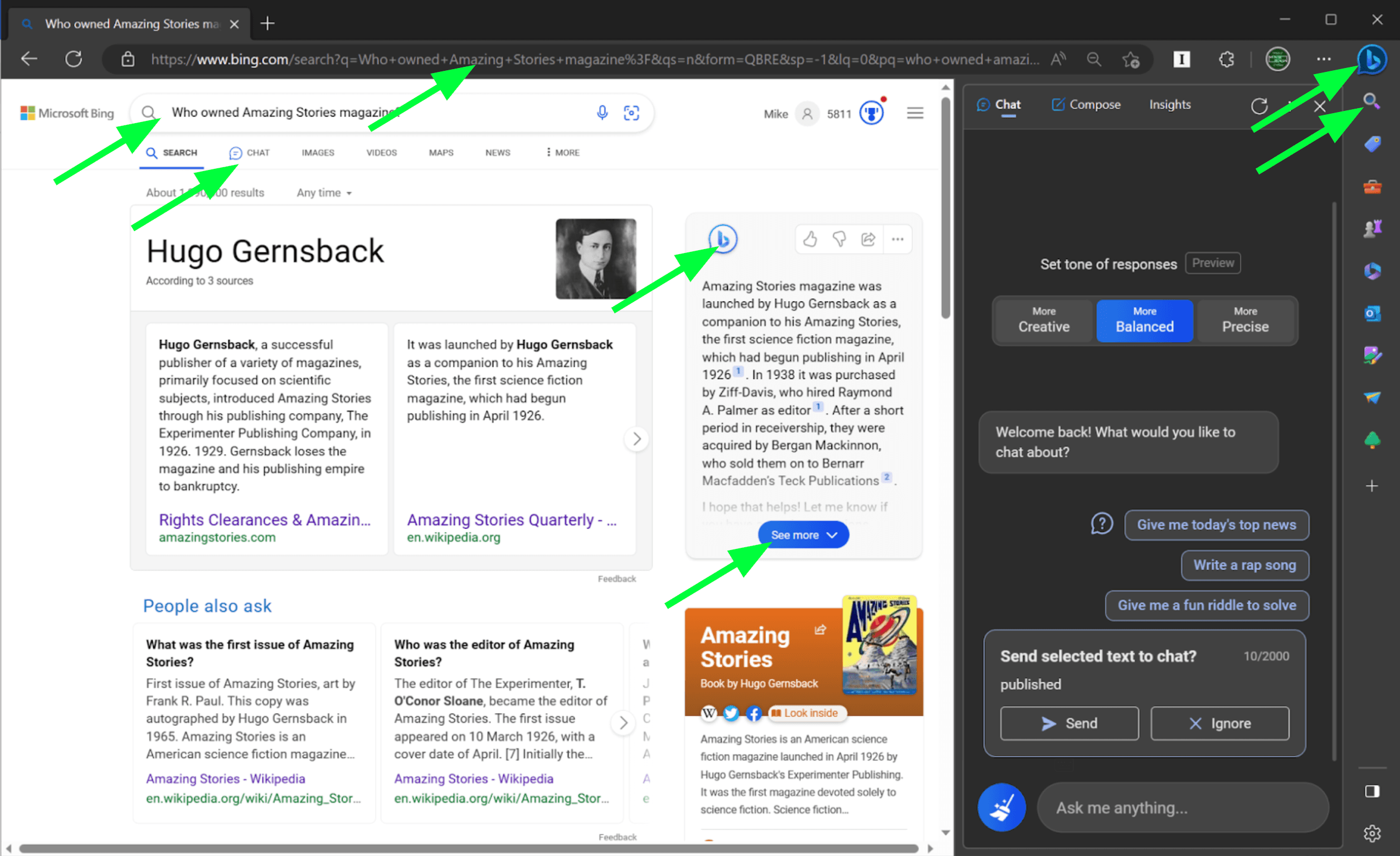
Mistyped web addresses in the address bar initiate chat sessions because that counts as a search. This is now the default experience on Windows with the included browser. You have to actively work to turn it off or download an alternative browser like Chrome to avoid this behavior.
This is significant because as Windows operating systems and laptops get upgraded, all defaults reset back to Bing, setting the stage for a battle that Microsoft could win through attrition alone. At some point, the default search engine is given a chance by users tired of going through the rigmarole of customization and discover that Bing is actually pretty good.
While this heavy handed approach would appear to be inevitably effective, Google’s success in motivating Chrome installs buys Google some time. According to Bing itself:
There are several websites that track browser market share. According to W3Counter, Chrome accounts for 63% of the total market share for all browsers worldwide. According to Global Stats StatCounter, as of November 2020 Chrome holds a whopping 70.33% of the desktop browser market share worldwide. More precisely, Chrome dominates the global web browser market with a whopping 65.68% share. The only other browser on the market that has a somewhat considerable share is Safari, with 18.68%.
Consequently, all of Microsoft’s effort to make Bing the default search engine on desktop is blocked by Google’s success to date. But we know Edge is based on Chrome, so does Edge show up as Chrome in these statistics? Again, according to Bing:
No, Edge users are not reported as Chrome users in these statistics. According to Kinsta, Microsoft Edge has a desktop browser market share of 5.83%. According to WPOven Blog, Microsoft’s Edge is at the second position with 7.75% browser market share. According to WebTribunal, Microsoft Edge has a desktop browser market share of 10.07%.
…leaving us to conclude, after calculating Apple out of the equation, that only about 1 in 8, or 12.5% of desktop users don’t go through the trouble of replacing the default Windows browser with Chrome, which I speculate is still a residual effect of the non-standard and now retired Internet Explorer. Aggressive pushing of Windows 11 upgrades and new hardware will likely increase Edge market share and drive up exposure to the Bing search + chat experience. Microsoft now requires a Microsoft account to install Windows, which also happens to be the requirement for The New Bing.
March 21, 2023: Google Announces Bard Availability with Limited Features
On March 21, 2023, Google announced that they are granting access to Bard to people on the waiting list. Feature-wise, Bard came out very sparse. No citations. No links. No images. No ads. I received access to Bard 2 days later and ran some rudimentary experiments on the features I felt most relevant at the time, awareness of current events.
Most notably, Google Bard stands on its own domain, bard.google.com, and is not integrated into the main Google search experience. This is a stark difference from Bing, which has integrated chat into the main search experience. This is significant because it means that Google Bard is not positioning itself as an alternative search engine experience, nor even an enhanced one, but rather as just a chatbot, and thus readily dismissed by the serious searcher.
As far as other features go, it can be added that Bard simultaneously offers 3 alternative responses to a prompt, but this can hardly be counted as a feature over Bing as it closely resembles Bing’s “Tone Control” feature.
March 27, 2023: Bing Raises Question Limit to 20
By March 27, the Bing question-limit was upped to 20, bringing us to where it stands today. The visibly aggressive roll-out of new features slowed down, and over the last month there has been very little new. Microsoft has been fine-tuning under what conditions chat sessions are initiated.

March 28, 2023: Bard Now Includes Citations, though Limited in Integration and Accessibility
As of March 28, 2023, Bard can give citations. It was not announced and may have been there longer. It is not well integrated and only appends a few links to the end under circumstances Bard deems appropriate. It is not clear how Bard decides when to give citations and when not to.
When citations are given, they are only ever appended at the end of the chat response, and never embedded and hyperlinked inline with accompanying footnote-style numbering as with Bing. Additionally, the citations are not in the copyable text. If you actually want to “lift” the citation links and use them in other places such as articles like this one, it can be quite a struggle.
April 21, 2023: Bard Introduces Coding Capability and Integration with Colab
The last significant development in the chatbot space was Bard’s ability to provide code, announced April 21, 2023. From March 28 when limited citation capability appeared in Bard to April 21 when coding ability was announced is absolutely glacial in terms of the development speed we’ve been seeing.
On the plus side, perhaps the most exciting unannounced aspect of the coding feature is that when you ask Bard to code something, it will actually hide under the lower-right triple-dot menu the ability to “Export to Colab” and actually run the code in a cloud-based Notebook environment.
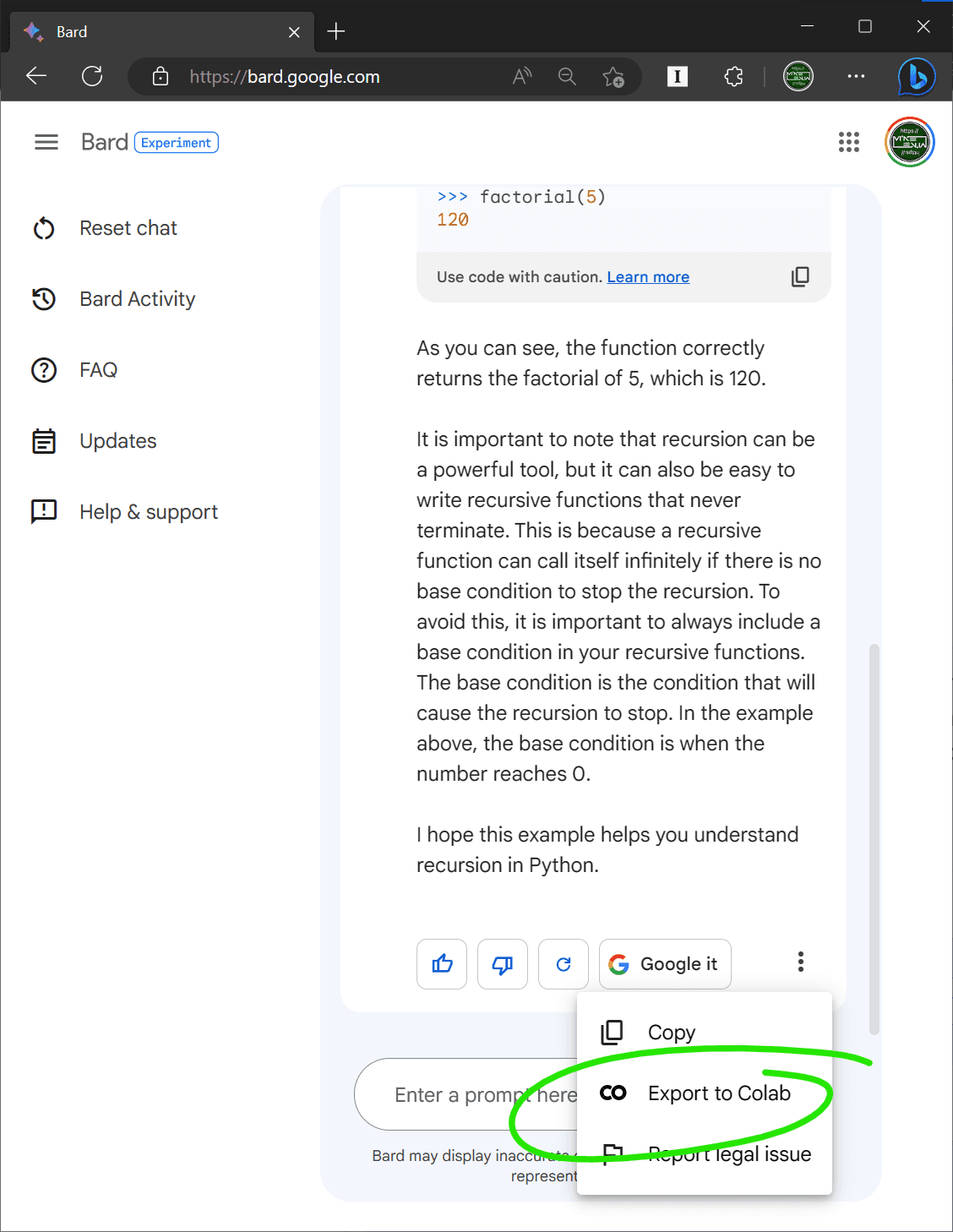
Can a Bards or Magis beat a Lich in a Joust?
My habits are formed. Microsoft was successful conditioning me to always give the conversational search model a try first. I’ve overridden most of the default browser settings Microsoft originally mandated as a condition of using Bing, most notably making the search bar default to Google when it’s not an exact web address typed in. And it’s not insignificant to point out that Edge is always my first choice browser because even with your Microsoft login on Chrome, and even with the appearance of all the Chat UI elements, any attempt to click them will tell you that Chat mode is only available when you have access to new Bing.
Being that I know that I do have access to the new Bing on that very same Microsoft user account that I’m logged in as under that Chrome session, I wonder what it is that they’re trying to tell me? Latest episode of the Browser Wars, much?
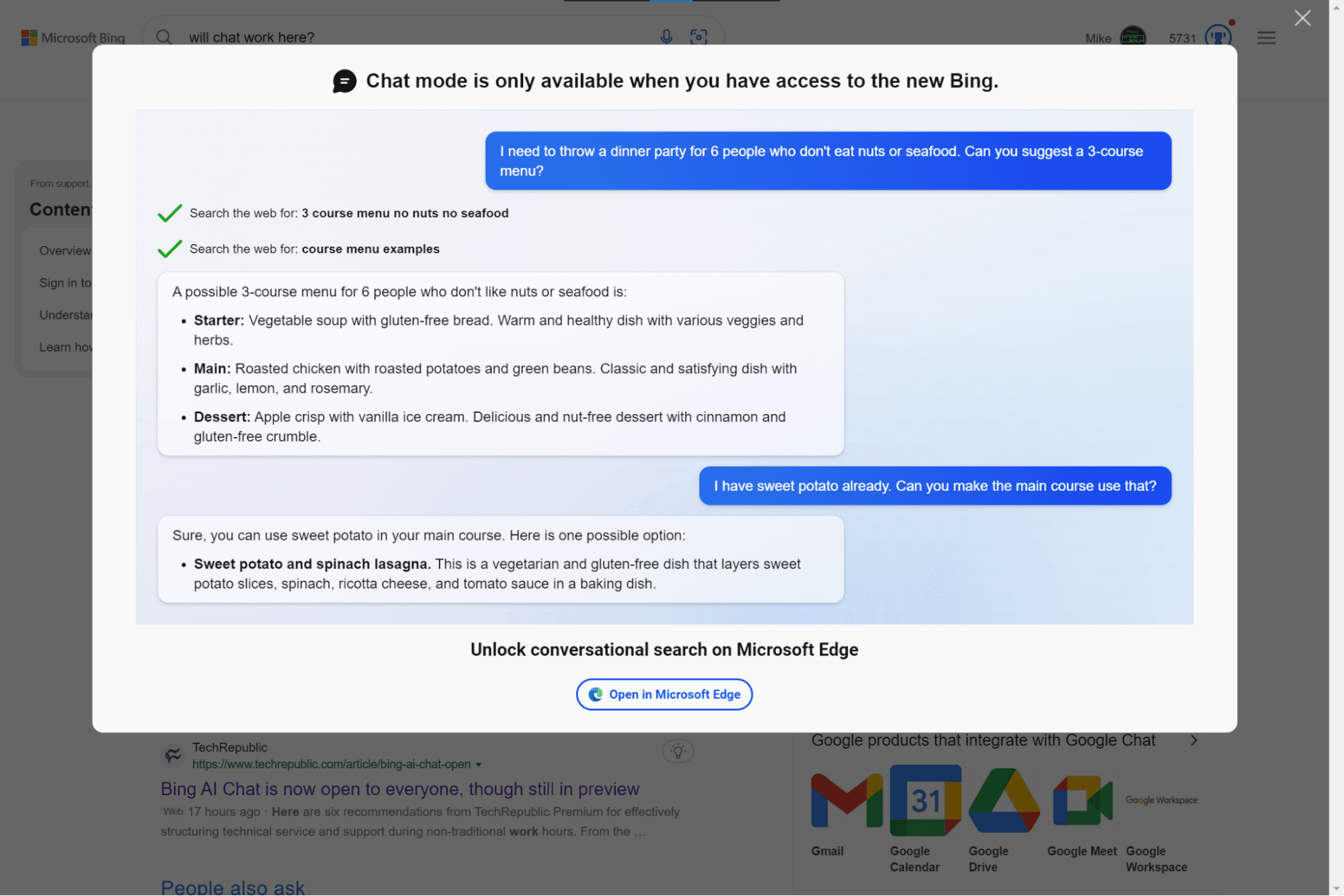
What Google’s catch-up game is going to be is uncertain. Bard doesn’t seem like it could be the end game, and indeed Google has already announced the latest in its Dungeons & Dragons campaign: Magi, but few details are known. Perhaps Google has something in store for us that will blow our minds and make the new Bing… well, look like the old Bing. Or maybe it’s just that finally the Lich woke up, and Google is not ready to play. Bards and Magis may have no chance trying to joust a Lich.
MARKETING
YouTube Ad Specs, Sizes, and Examples [2024 Update]
![YouTube Ad Specs, Sizes, and Examples [2024 Update] YouTube Ad Specs, Sizes, and Examples](https://articles.entireweb.com/wp-content/uploads/2024/06/YouTube-Ad-Specs-Sizes-and-Examples.jpg)
Introduction
With billions of users each month, YouTube is the world’s second largest search engine and top website for video content. This makes it a great place for advertising. To succeed, advertisers need to follow the correct YouTube ad specifications. These rules help your ad reach more viewers, increasing the chance of gaining new customers and boosting brand awareness.
Types of YouTube Ads
Video Ads
- Description: These play before, during, or after a YouTube video on computers or mobile devices.
- Types:
- In-stream ads: Can be skippable or non-skippable.
- Bumper ads: Non-skippable, short ads that play before, during, or after a video.
Display Ads
- Description: These appear in different spots on YouTube and usually use text or static images.
- Note: YouTube does not support display image ads directly on its app, but these can be targeted to YouTube.com through Google Display Network (GDN).
Companion Banners
- Description: Appears to the right of the YouTube player on desktop.
- Requirement: Must be purchased alongside In-stream ads, Bumper ads, or In-feed ads.
In-feed Ads
- Description: Resemble videos with images, headlines, and text. They link to a public or unlisted YouTube video.
Outstream Ads
- Description: Mobile-only video ads that play outside of YouTube, on websites and apps within the Google video partner network.
Masthead Ads
- Description: Premium, high-visibility banner ads displayed at the top of the YouTube homepage for both desktop and mobile users.
YouTube Ad Specs by Type
Skippable In-stream Video Ads
- Placement: Before, during, or after a YouTube video.
- Resolution:
- Horizontal: 1920 x 1080px
- Vertical: 1080 x 1920px
- Square: 1080 x 1080px
- Aspect Ratio:
- Horizontal: 16:9
- Vertical: 9:16
- Square: 1:1
- Length:
- Awareness: 15-20 seconds
- Consideration: 2-3 minutes
- Action: 15-20 seconds
Non-skippable In-stream Video Ads
- Description: Must be watched completely before the main video.
- Length: 15 seconds (or 20 seconds in certain markets).
- Resolution:
- Horizontal: 1920 x 1080px
- Vertical: 1080 x 1920px
- Square: 1080 x 1080px
- Aspect Ratio:
- Horizontal: 16:9
- Vertical: 9:16
- Square: 1:1
Bumper Ads
- Length: Maximum 6 seconds.
- File Format: MP4, Quicktime, AVI, ASF, Windows Media, or MPEG.
- Resolution:
- Horizontal: 640 x 360px
- Vertical: 480 x 360px
In-feed Ads
- Description: Show alongside YouTube content, like search results or the Home feed.
- Resolution:
- Horizontal: 1920 x 1080px
- Vertical: 1080 x 1920px
- Square: 1080 x 1080px
- Aspect Ratio:
- Horizontal: 16:9
- Square: 1:1
- Length:
- Awareness: 15-20 seconds
- Consideration: 2-3 minutes
- Headline/Description:
- Headline: Up to 2 lines, 40 characters per line
- Description: Up to 2 lines, 35 characters per line
Display Ads
- Description: Static images or animated media that appear on YouTube next to video suggestions, in search results, or on the homepage.
- Image Size: 300×60 pixels.
- File Type: GIF, JPG, PNG.
- File Size: Max 150KB.
- Max Animation Length: 30 seconds.
Outstream Ads
- Description: Mobile-only video ads that appear on websites and apps within the Google video partner network, not on YouTube itself.
- Logo Specs:
- Square: 1:1 (200 x 200px).
- File Type: JPG, GIF, PNG.
- Max Size: 200KB.
Masthead Ads
- Description: High-visibility ads at the top of the YouTube homepage.
- Resolution: 1920 x 1080 or higher.
- File Type: JPG or PNG (without transparency).
Conclusion
YouTube offers a variety of ad formats to reach audiences effectively in 2024. Whether you want to build brand awareness, drive conversions, or target specific demographics, YouTube provides a dynamic platform for your advertising needs. Always follow Google’s advertising policies and the technical ad specs to ensure your ads perform their best. Ready to start using YouTube ads? Contact us today to get started!
MARKETING
Why We Are Always ‘Clicking to Buy’, According to Psychologists

Amazon pillows.
MARKETING
A deeper dive into data, personalization and Copilots

Salesforce launched a collection of new, generative AI-related products at Connections in Chicago this week. They included new Einstein Copilots for marketers and merchants and Einstein Personalization.
To better understand, not only the potential impact of the new products, but the evolving Salesforce architecture, we sat down with Bobby Jania, CMO, Marketing Cloud.
Dig deeper: Salesforce piles on the Einstein Copilots
Salesforce’s evolving architecture
It’s hard to deny that Salesforce likes coming up with new names for platforms and products (what happened to Customer 360?) and this can sometimes make the observer wonder if something is brand new, or old but with a brand new name. In particular, what exactly is Einstein 1 and how is it related to Salesforce Data Cloud?
“Data Cloud is built on the Einstein 1 platform,” Jania explained. “The Einstein 1 platform is our entire Salesforce platform and that includes products like Sales Cloud, Service Cloud — that it includes the original idea of Salesforce not just being in the cloud, but being multi-tenancy.”
Data Cloud — not an acquisition, of course — was built natively on that platform. It was the first product built on Hyperforce, Salesforce’s new cloud infrastructure architecture. “Since Data Cloud was on what we now call the Einstein 1 platform from Day One, it has always natively connected to, and been able to read anything in Sales Cloud, Service Cloud [and so on]. On top of that, we can now bring in, not only structured but unstructured data.”
That’s a significant progression from the position, several years ago, when Salesforce had stitched together a platform around various acquisitions (ExactTarget, for example) that didn’t necessarily talk to each other.
“At times, what we would do is have a kind of behind-the-scenes flow where data from one product could be moved into another product,” said Jania, “but in many of those cases the data would then be in both, whereas now the data is in Data Cloud. Tableau will run natively off Data Cloud; Commerce Cloud, Service Cloud, Marketing Cloud — they’re all going to the same operational customer profile.” They’re not copying the data from Data Cloud, Jania confirmed.
Another thing to know is tit’s possible for Salesforce customers to import their own datasets into Data Cloud. “We wanted to create a federated data model,” said Jania. “If you’re using Snowflake, for example, we more or less virtually sit on your data lake. The value we add is that we will look at all your data and help you form these operational customer profiles.”
Let’s learn more about Einstein Copilot
“Copilot means that I have an assistant with me in the tool where I need to be working that contextually knows what I am trying to do and helps me at every step of the process,” Jania said.
For marketers, this might begin with a campaign brief developed with Copilot’s assistance, the identification of an audience based on the brief, and then the development of email or other content. “What’s really cool is the idea of Einstein Studio where our customers will create actions [for Copilot] that we hadn’t even thought about.”
Here’s a key insight (back to nomenclature). We reported on Copilot for markets, Copilot for merchants, Copilot for shoppers. It turns out, however, that there is just one Copilot, Einstein Copilot, and these are use cases. “There’s just one Copilot, we just add these for a little clarity; we’re going to talk about marketing use cases, about shoppers’ use cases. These are actions for the marketing use cases we built out of the box; you can build your own.”
It’s surely going to take a little time for marketers to learn to work easily with Copilot. “There’s always time for adoption,” Jania agreed. “What is directly connected with this is, this is my ninth Connections and this one has the most hands-on training that I’ve seen since 2014 — and a lot of that is getting people using Data Cloud, using these tools rather than just being given a demo.”
What’s new about Einstein Personalization
Salesforce Einstein has been around since 2016 and many of the use cases seem to have involved personalization in various forms. What’s new?
“Einstein Personalization is a real-time decision engine and it’s going to choose next-best-action, next-best-offer. What is new is that it’s a service now that runs natively on top of Data Cloud.” A lot of real-time decision engines need their own set of data that might actually be a subset of data. “Einstein Personalization is going to look holistically at a customer and recommend a next-best-action that could be natively surfaced in Service Cloud, Sales Cloud or Marketing Cloud.”
Finally, trust
One feature of the presentations at Connections was the reassurance that, although public LLMs like ChatGPT could be selected for application to customer data, none of that data would be retained by the LLMs. Is this just a matter of written agreements? No, not just that, said Jania.
“In the Einstein Trust Layer, all of the data, when it connects to an LLM, runs through our gateway. If there was a prompt that had personally identifiable information — a credit card number, an email address — at a mimum, all that is stripped out. The LLMs do not store the output; we store the output for auditing back in Salesforce. Any output that comes back through our gateway is logged in our system; it runs through a toxicity model; and only at the end do we put PII data back into the answer. There are real pieces beyond a handshake that this data is safe.”
-
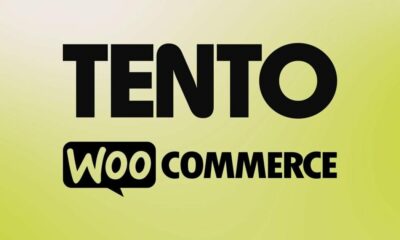
 WORDPRESS7 days ago
WORDPRESS7 days agoTento Launches as Exclusive Lending Partner for WooCommerce
-
SEARCHENGINES7 days ago
Daily Search Forum Recap: August 21, 2024
-

 SEO7 days ago
SEO7 days agoGoogle Offers Solutions for Inaccurate Product Pricing In Search
-
SEARCHENGINES6 days ago
Daily Search Forum Recap: August 22, 2024
-
SEARCHENGINES5 days ago
Daily Search Forum Recap: August 23, 2024
-
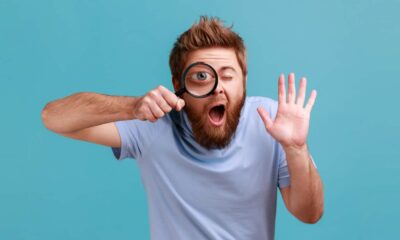
 SEO6 days ago
SEO6 days agoData Confirms Disruptive Potential Of SearchGPT
-
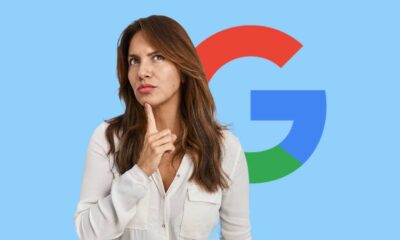
 SEO4 days ago
SEO4 days agoGoogle Cautions On Improper 404 Handling
-
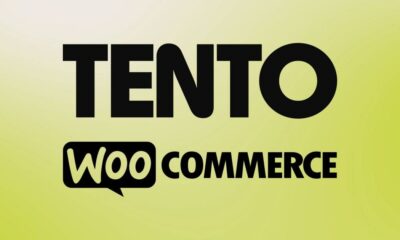
 WORDPRESS6 days ago
WORDPRESS6 days agoTento Launches as Exclusive Lending Partner for WooCommerce





